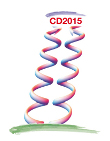Conveners
Parallel Session 1 - Few-Body Physics WG
- Dean Lee (North Carolina State University)
- Akaki Rusetsky (HISKP, University of Bonn)
- Assumpta Parreno Garcia (University of Barcelona)
Martin Savage
(Institute for Nuclear Theory, Seattle)
29/06/2015, 14:30
Few-Body Physics Working Group
Talk
I will present the recent results of lattice QCD calculations of the interactions of nucleons and light nuclei with magnetic fields. Their magnetic moments and polarizabilities have been calculated at pion masses of 805 MeV and 450 MeV. Interestingly, the magnetic moments, when given in terms of natural nuclear magnetons, are found to be consistent with the experimental values. I also present...
David Wilson
(Old Dominion University, Norfolk)
29/06/2015, 14:55
Few-Body Physics Working Group
Talk
Recently it has become possible to obtain coupled-channel scattering amplitudes using lattice QCD. Using a large basis of operators we are able to obtain a reliable finite volume spectrum describing the coupled pi-K, eta-K system. Utilizing the finite volume formalism proposed by Luescher and extended by several others, we are able to describe the spectra from each lattice symmetry group and...
Lorenzo Contessi
(TIFP, Trento)
29/06/2015, 15:10
Few-Body Physics Working Group
Talk
In the last years Lattice QCD has substantially improved its predictive power for light nuclei [1,2,3]. Now we have access to data for light nuclei in systems with high pionic mass. We argue that the proper low-energy theory is a contact (or pionless) approach, since for these systems pion effects are of short-range. By means of this effective theory it is possible to extend LQCD predictions...
Vadim Baru
(Ruhr University, Bochum)
29/06/2015, 15:25
Few-Body Physics Working Group
Talk
The low-energy theorems (LET) for NN scattering are known to provide important relations between the coefficients in the effective-range expansion (ERE) of the amplitude, which are governed by the long-range part of the potential, see, e.g., [1, 2]. Therefore, as long as the long-range physics is appropriately included in the calculation, these relations should yield model independent...
Vladimir Pascalutsa
(Johannes Gutenberg University, Mainz)
29/06/2015, 15:40
Few-Body Physics Working Group
Talk
The present treatment of the nucleon-nucleon and few-nucleon forces in chiral effective theory is semi-relativistic. One of the immediate difficulties of this description is that, in accordance with Wigner’s causality bound, the leading-order (zero-range) interaction yields zero effective range. This leads to the necessity of “promoting” the subleading three-body force to leading order, in the...

